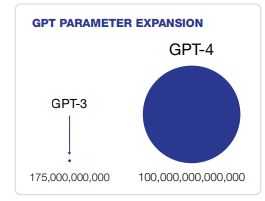- within Insolvency/Bankruptcy/Re-Structuring, Criminal Law, Litigation and Mediation & Arbitration topic(s)
News about ChatGPT, Chinchilla, Sparse Lumina base and other AI platforms is flooding the media for good reason. In an unprecedented five-day span, ChatGPT achieved one million users, outpacing previously set records by Netflix (3.5 years), Airbnb (2.5 years), Facebook (10 months), Instagram (2.5 months) and iPhone (74 days).
Fueling momentum, Microsoft announced an additional $10 billion investment in Open AI, parent of ChatGPT, and will make the service available through their Azure cloud platform to enterprise customers.
GPT-4, set to release in Q1 2023, touts 100 trillion parameters entirely eclipsing the 175 billion parameters offered by GPT-3. As data quantity, quality and algorithms continue to improve, as they have with GPT-3, the implications and possibilities for the application across an enterprise are astounding.

GPT-4 will be the most powerful technology available through low code in history and will fundamentally transform every element of a modern organization including marketing, sales, product development human resources and supply chain.
Like Google search in 1999, advanced AI tools like ChatGPT will transform every organization on the planet. ChatGPT can write an article about AI in less than five minutes (see ChatGPT, write an article on the impact of AI on Corporations) and it will be nearly as good as one that an expert could write in five hours.
AI is the next transformative force in business. Over the subsequent 24 months, it will fundamentally change customer expectations, bring about new and innovative business models, change how people work and dramatically improve the performance of organizations.
What are the practical, near-term applications to business? Here are three, real-life examples of how the transformative power of AI has already been realized.
A telecommunications company headquartered on the East Coast is now able to design, test and launch a new personalized customer experience that brings sales at a lower cost per acquisition (CPA) within weeks versus months. That's a fundamental shift in the customer acquisition equation.
A consumer goods company that spends over a billion dollars in media now uses an AI/ML approach to optimize media and promotional spend by running thousands of simulations analyzing millions of signals. With surgical precision, they can cut investments without impacting sales. This is an example of an AI solution that can now be implemented within weeks, saving companies up to 20 percent of their media and promotional budget, all while increasing sales.
A manufacturing company in the Midwest uses AI-based demand sensing to adjust inventory by recognizing new customer buying frequencies, macro-economic events, promotional and other indirect effects with a lot less data and significant improvement in forecast accuracy.
This delivers immediate value by reducing stockouts and increasing inventory turn. And this is all just the beginning. The C-suite leaders A&M speaks with aren't questioning AI's potential disruptive impact to profit pools or the fact that it will drive the next wave of transformation in organizations. Instead, they are focused on three things:
- Developing a game plan: Formulate an AI strategy and roadmap that frames the vision, value delivered and operating model for the transformation.
- Identifying quick wins: Get self-funded projects like the examples above up and running to quickly deliver value and build momentum across the organization.
- Building partnerships: Develop the partnerships needed to co-source, not outsource, an AI platform and capabilities, ensuring they build the AI muscle and internet protocol (IP) internally.
While the first chapter of digital transformation was focused on digital platforms like Google, Meta and Adobe, the next chapter will be about the Artificial Intelligence transformation that will change how people shop, work, learn, operate organizations and create value. Get ready for an amazing journey!
Originally published March 1, 2023
The content of this article is intended to provide a general guide to the subject matter. Specialist advice should be sought about your specific circumstances.


